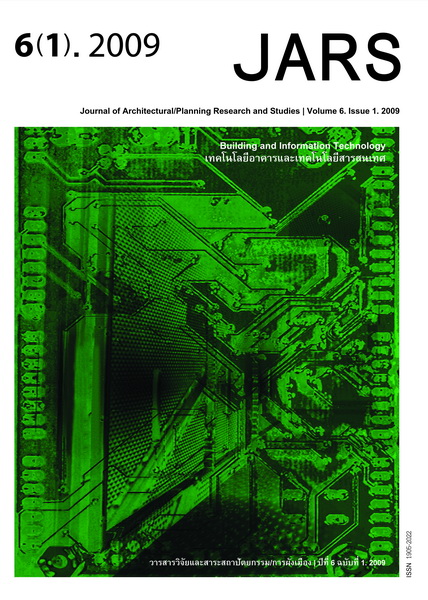The Assessment of Building Energy Performance: Thammasat University, Rangsit Campus
Main Article Content
Abstract
This research aims to assess buildings in terms of energy performance and propose the appropriate guidelines to renovate buildings in Thammasat University, Rangsit Campus. By investigating, collecting, and analyzing data of the selected buildings in present condition in various aspects, the results indicated that the overall energy performances of buildings were lower than minimum criteria. Principal causes of failure can be concluded as follows 1) some buildings were designed before the Energy Conservation Promotion Act B.E. 2535 was announced, so the architects had no guidelines to follow 2) because the policy of energy conservation of buildings in campus had not been clearly defined, the energy performance of the new buildings were not considered 3) the cooling technique was changed from natural ventilation to air conditioning, but the building components were not improved 4) no energy conservation-expert team participated in design and development processes and 5) in terms of management, neglectful behaviors directly affected on energy consumption. For better performance, thermal heat gain must be decreased by 1) adding insulation to walls and roofs 2) providing effective shading devices 3) shading the buildings and surrounding with vegetations and 4) air conditioning using must be managed.
Downloads
Article Details

This work is licensed under a Creative Commons Attribution-NonCommercial-NoDerivatives 4.0 International License.
All material is licensed under the terms of the Creative Commons Attribution 4.0 International (CC-BY-NC-ND 4.0) License, unless otherwise stated. As such, authors are free to share, copy, and redistribute the material in any medium or format. The authors must give appropriate credit, provide a link to the license, and indicate if changes were made. The authors may do so in any reasonable manner, but not in any way that suggests the licensor endorses you or your use. The authors may not use the material for commercial purposes. If the authors remix, transform, or build upon the material, they may not distribute the modified material, unless permission is obtained from JARS. Final, accepted versions of the paper may be posted on third party repositories, provided appropriate acknowledgement to the original source is clearly noted.
References
Boonyatikarn, S. (1993). การออกแบบเพื่อประหยัดพลังงานในสภาพภูมิอากาศแบบร้อนชื้นแบบเมืองไทย [Energy conservation design for hot-humid climate in Thailand]. Faculty of Architecture Academic Journal, 16-24.
Boonyatikarn, S. (1998). การประยุกต์ใช้แสงธรรมชาติในอาคาร [Daylighting application in building]. ASA, 7, 94-105.
Boonyatikarn, S. (2002). การออกแบบประสานระบบมหาวิทยาลัยชินวัตร [The integrated design of Shinawatara University]. Bangkok, Thailand: G M Max Media.
Boonyatikarn, S. (2007). นวัตกรรมการใช้กระจกสำหรับเมืองร้อนชื้น [The innovation of glazing for hot-humid countries]. Nontaburi, Thailand: Cool Print.
Chenvidyakarn T. (2008). Passive design for thermal comfort in hot humid climates. Journal of Architectural/Planning Research and Studies, 5(1), 1-28.
Chindawanik, T. (2003). การประหยัดพลังงานในอาคาร [Energy conservation in building]. Retrieved December 3, 2008, from http://www.engineeringtoday.net/magazine/articledetail.asp?arid=537&pid=74
Department of Alternative Energy Development and Efficiency (DEDE). (2007). คู่มือแบบประเมินอาคารประหยัดพลังงานและเป็นมิตรต่อสิ่งแวดล้อมสำหรับอาคารี่ ไม่ใช่อาคารพักอาศัย [The manual of energy conservation and environmental friendly assessment for non-residential building]. Bangkok, Thailand: Chulalongkorn University Press.
Horayangkura, V., Inpuntung, V., & Chantavilasvong, S. (2001). รายงานการวิจัย สถานภาพผลงานทางวิชาการสาขาสถาปตยกรรมในประเทศไทย [The status of academic output in architecture in Thailand]. Bangkok, Thailand: T.C.G. Printing.
Illuminating Engineering Society of North America. (1981). IES lighting handbook, 1981 reference volume. New York: Illuminating Engineering Society.
Saihong, N., & Srisutapan, A. (2007). แนวทางการออกแบบแสงสว่างในห้องเรียนสื่อผสม [Guidelines for lighting design in multimedia classroom]. Journal of Architectural/Planning Research and Studies, 5(1), 65-81.
Srisutapan, A., & Tisavipat, P. (2004). การเพิ่มประสิทธิภาพการใช้งานอาคาร กรณีศึกษา: อาคารหอสมุดป๋วย อึ้งภากรณ์ มหาวิทยาลัยธรรมศาสตร์ ศูนย์รังสิต [The promoting of building effiency through building modification: Puey Ungphakorn Library Thammasat University, Rangsit Campus]. Pathum Thani, Thailand: Faculty of Architecture and Planning.
Thammavijitdej, P., & Horayangkura, V. (2006). Interdisciplinary confilcts and resolution as cutural behavior among architects and engineers. Thammasat Review, 11(1), 50-64.


